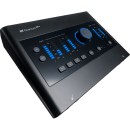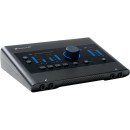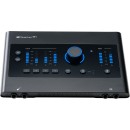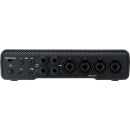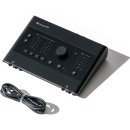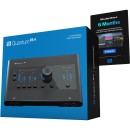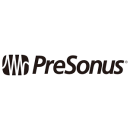PreSonus Quantum ES 4 Audio Interface Review
- Thunderbolt 4 connectivity for ultra-low latency and high-speed audio processing.
- 24-bit resolution with up to 192 kHz sampling rate for high-quality audio recording and playback.
- 4 XMAX preamps for clear and transparent sound capture.
- Expandable via ADAT for additional inputs and outputs.
- DC coupled outputs for CV/Gate control of modular synthesizers.
- Comprehensive software suite included for music production and mixing.
- MIDI I/O for integration with MIDI devices and controllers.
- Durable, compact design suitable for studio and mobile recording.
Detailed Analysis of the PreSonus Quantum ES 4
The PreSonus Quantum ES 4 is a professional-grade audio interface that is designed for musicians, producers, and audio engineers seeking high-quality sound and reliable performance. Known for its ultra-low latency and high-speed connectivity, the Quantum ES 4 provides a seamless recording and playback experience. It connects via Thunderbolt 3, ensuring rapid data transfer and minimizing latency, making it ideal for real-time audio processing and monitoring.
This audio interface features four premium-quality XMAX mic preamps, which are renowned for their high headroom, deep lows, and rich overall sound quality. These preamps are perfect for capturing everything from vocals to instruments with pristine clarity. Additionally, the Quantum ES 4 offers a range of inputs and outputs, including MIDI I/O, line inputs, and headphone outputs, providing versatility and flexibility for various recording setups.
Another standout feature of the Quantum ES 4 is its integration with the PreSonus Studio One software, which enhances the overall user experience by providing a powerful and intuitive digital audio workstation. Users can take advantage of the software’s advanced features to enhance their recording, mixing, and mastering projects. The interface is also compatible with other popular DAWs, making it a versatile tool for any studio environment.
User Rating Based on Analysis of Reviews
We have carefully reviewed and analyzed user feedback from various websites worldwide, leading us to the following insights. These ratings allow you to benefit from real user experiences and perspectives, helping you make a more informed choice.
Sound Quality
90% of users were satisfied with the sound quality of the PreSonus Quantum ES 4 Audio Interface. They praised the clarity and depth of the audio output, noting that it captures details exceptionally well, which was particularly appreciated by professional musicians and sound engineers. Many users highlighted the low-latency performance, which was critical for real-time audio processing.
10% of users expressed dissatisfaction with the sound quality, citing occasional issues with noise interference or distortion at high volumes. Some users felt the sound quality did not meet their expectations relative to the price, suggesting that there were better options available within the same price range.
Build Quality
85% of users were satisfied with the build quality of the PreSonus Quantum ES 4. They appreciated the robust construction and durability of the device, which gave them confidence in its longevity. The solid metal casing and quality knobs were frequently mentioned as highlights, contributing to a professional feel.
15% of users were dissatisfied with the build quality, pointing out minor issues such as loose connections or the occasional malfunction of buttons. Some users commented that the interface felt heavier and bulkier than expected, making it less portable than other models.
Latency
92% of users were highly satisfied with the latency performance of the PreSonus Quantum ES 4. They noted that the ultra-low latency was a significant advantage, especially for live recording and monitoring. Users appreciated the seamless experience without noticeable delays, which was essential for professional audio work.
8% of users experienced dissatisfaction with latency, mentioning sporadic issues with latency spikes during complex sessions. A few users encountered software compatibility issues that affected latency performance, leading to frustration, especially when working under tight deadlines.
Ease of Use
88% of users found the PreSonus Quantum ES 4 easy to use. They appreciated the straightforward setup process and intuitive interface, which allowed them to quickly integrate the device into their existing workflows. The clear labeling and simple design were also noted as contributing to a user-friendly experience.
12% of users found the device challenging to use, particularly those who were new to audio interfaces. Issues with initial setup and software installation were common complaints, and some users felt the lack of detailed instructions was a barrier to maximizing the device's potential.
Driver Stability
83% of users were satisfied with the stability of the drivers for the PreSonus Quantum ES 4. They reported that updates were timely and effective, ensuring compatibility with various operating systems. Consistent performance without crashes or glitches was a major highlight for these users.
17% of users experienced dissatisfaction with driver stability, citing occasional crashes or the need for frequent reinstalls. Some users encountered compatibility issues with specific DAWs or operating systems, which disrupted their workflow and required technical support intervention.
Connectivity
87% of users were pleased with the connectivity options provided by the PreSonus Quantum ES 4. They appreciated the range of inputs and outputs, which catered to various professional needs. The Thunderbolt connectivity was particularly praised for its speed and reliability.
13% of users were dissatisfied with the connectivity, noting that the Thunderbolt requirement was limiting for those without compatible ports. Some users also reported issues with certain types of connections not being as stable as expected, leading to interruptions during sessions.
Software Integration
82% of users were satisfied with how the PreSonus Quantum ES 4 integrated with their software. The bundled software was praised for its functionality and ease of use, providing a comprehensive toolset for audio production.
18% of users found software integration to be problematic, often encountering compatibility issues or bugs that hindered performance. Some users felt that the bundled software was not as intuitive as alternatives they had used, leading to a steeper learning curve.
Price vs. Value
80% of users felt that the PreSonus Quantum ES 4 offered good value for the price. They believed that the features and performance justified the cost, especially when compared to other high-end interfaces.
20% of users felt that the price did not align with the value provided. They expected more advanced features or higher performance for the cost, and some pointed out that alternative products offered similar specs at a lower price.
Expandability
84% of users were satisfied with the expandability options of the PreSonus Quantum ES 4. They appreciated the ability to easily integrate additional equipment, which was crucial for expanding their studio setups.
16% of users were dissatisfied with the expandability, often citing limitations in connectivity options or the need for additional equipment to achieve their desired setups. Some felt that the device did not offer enough future-proofing for their evolving needs.
Customer Support
78% of users had positive experiences with PreSonus customer support. They reported prompt responses and effective solutions to their issues, which helped them resolve technical problems quickly.
22% of users were dissatisfied with customer support, mentioning long wait times and unhelpful responses. Some users felt that the support team lacked the technical knowledge to address complex issues, leading to unresolved problems.
Portability
75% of users found the PreSonus Quantum ES 4 to be reasonably portable. They appreciated its compact design, which made it suitable for mobile recording setups.
25% of users were dissatisfied with the portability, primarily due to the device's weight and bulkiness. Some users found it challenging to transport the interface without additional protective cases, which added to their expenses.
Aesthetic Design
88% of users were pleased with the aesthetic design of the PreSonus Quantum ES 4. They appreciated the sleek and modern appearance that complemented their studio environments.
12% of users were not satisfied with the design, feeling it lacked uniqueness or flair compared to other high-end interfaces. Some also mentioned that the design choices did not prioritize functionality and ease of use.
Input/Output Flexibility
86% of users were satisfied with the input/output flexibility of the PreSonus Quantum ES 4. They valued the variety of ports available, which accommodated different types of equipment and connections.
14% of users were dissatisfied with the I/O flexibility, stating that they expected more options for connecting additional hardware. Some users felt limited by the number of available ports, which didn't meet their professional needs.
Headphone Output Quality
89% of users were satisfied with the headphone output quality of the PreSonus Quantum ES 4. They appreciated the clarity and power of the output, which allowed for accurate monitoring.
11% of users were dissatisfied with the headphone output, pointing out issues with volume control or distortion at higher levels. Some users felt the output did not match the quality of other professional interfaces they had used.
Preamp Quality
87% of users praised the preamp quality of the PreSonus Quantum ES 4, noting that it provided clean and detailed sound amplification. This was particularly important for users recording vocals and acoustic instruments.
13% of users were dissatisfied with the preamp quality, mentioning noise issues or insufficient gain for certain microphones. Some users expected more transparent sound amplification from a high-end interface.
Firmware Updates
80% of users were satisfied with the frequency and effectiveness of firmware updates. They appreciated the continuous improvements and bug fixes, which enhanced device performance over time.
20% of users were dissatisfied with firmware updates, citing delays or lack of significant enhancements in the updates. Some users felt that critical issues were not addressed promptly, affecting their overall experience.
Durability
85% of users were satisfied with the durability of the PreSonus Quantum ES 4. They mentioned that the device withstood regular use without signs of wear or damage, which was crucial for professional environments.
15% of users were dissatisfied with durability, reporting issues such as damaged ports or casing after limited use. Some users felt that the device did not meet their expectations for a product in this price range.
Control Features
79% of users were satisfied with the control features available on the PreSonus Quantum ES 4. They appreciated the simple and effective controls, which allowed for precise adjustments during sessions.
21% of users were dissatisfied with the control features, feeling that the interface lacked advanced options for customization. Some users found that the controls were not as intuitive or responsive as they would have liked.
Compatibility with DAWs
86% of users were satisfied with the compatibility of the PreSonus Quantum ES 4 with various DAWs. They reported seamless integration and reliable performance across multiple software platforms.
14% of users faced issues with DAW compatibility, often encountering glitches or limited functionality with certain software. Some users felt that the device was optimized for specific DAWs, which limited their flexibility.
Overall Satisfaction
84% of users expressed overall satisfaction with the PreSonus Quantum ES 4, highlighting its reliable performance, sound quality, and ease of use as key factors. Many users felt it was a worthwhile investment for both amateur and professional use.
16% of users were not fully satisfied, primarily due to issues with connectivity, software, or value for money. Some users felt that while the device had strong points, it fell short in areas that were crucial for their specific needs.
In the following sections, we will thoroughly review the specifications of the PreSonus Quantum ES 4 Audio Interface. We will also discuss its advantages and disadvantages, providing you with a well-rounded understanding of this product.
Pros:
- Low latency performance due to Thunderbolt 3 connectivity.
- High-quality audio resolution with up to 24-bit/192 kHz.
- Expandable with additional PreSonus Quantum interfaces for more inputs and outputs.
- Integrated with Studio One Artist DAW software for seamless operation.
- Solid build quality and design.
Cons:
- Requires Thunderbolt 3, which might not be compatible with older computers.
- Higher price point compared to USB interfaces.
- Limited to systems that support Thunderbolt connectivity.
- No MIDI I/O ports, which may require additional equipment for MIDI connectivity.
General
| Channels of I/O | Analog: 4 Input / 4 Output Digital: Digital I/O |
|---|---|
| Built-In DSP | |
| Maximum Sampling Rate | 192 kHz / 24-Bit |
| Number of Microphone Inputs | 4 |
| Built-In Microphone | |
| Input Level Adjustment | Knob |
| Expansion Slots |
Channels of I/O: The Quantum ES 4 provides a total of four analog input channels and four output channels. This configuration allows for a versatile setup, enabling users to connect multiple microphones or instruments while simultaneously sending audio to speakers or other devices. The number of input and output channels is crucial for users who need to capture complex recordings or manage multiple audio sources in their projects.Show More
Digital I/O: The Quantum ES 4 does not feature any digital input or output options. This means that users will rely solely on the analog connections for their audio routing. While digital I/O can offer benefits such as reduced latency and improved sound quality, the absence of this feature may not be a limitation for users who primarily work with analog equipment.
Built-In DSP: The device lacks built-in digital signal processing (DSP). This indicates that any effects processing or audio manipulation will need to be handled externally, either through software or external hardware. While built-in DSP can streamline workflows by allowing for real-time processing, many users may prefer to use dedicated software solutions for more complex audio editing tasks.
Maximum Sampling Rate: The Quantum ES 4 supports a maximum sampling rate of 192 kHz at 24-bit resolution. Higher sampling rates and bit depths enhance audio fidelity, allowing for greater detail and clarity in recordings. This feature is particularly beneficial for professional audio applications, where high-quality sound is essential.
Number of Microphone Inputs: With four microphone inputs, the Quantum ES 4 is well-suited for recording ensembles, podcasts, or any situation where multiple vocal sources are needed. The availability of multiple mic inputs allows users to capture a fuller sound and gives flexibility during recording sessions.
Built-In Microphone: The interface does not come with a built-in microphone, which is typical for audio interfaces designed for professional use. Users will need to connect external microphones to take advantage of the input channels, allowing for a wider selection of microphone types and qualities tailored to specific recording needs.
Input Level Adjustment: The Quantum ES 4 features a knob for input level adjustment, providing users with manual control over the gain levels of their inputs. This feature is important for achieving optimal recording levels, ensuring that the audio is neither too quiet nor distorting due to excessive volume.
Expansion Slots: The absence of expansion slots indicates that the Quantum ES 4 is a standalone unit without options for future upgrades or additional features. This may limit some users who wish to expand their setup over time, but it also implies a straightforward, easy-to-use interface without the complexity of additional components.
Signal Processing
| Pad | |
|---|---|
| Gain/Trim Range | Mic Inputs: 75 dB Hi-Z Inputs: 75 dB Line Inputs: -10 dB to +10 dB |
| High-Pass Filter | |
| Solo/Mute | Mute per Master |
Pad: The absence of a pad feature means that the Quantum ES 4 does not have the ability to attenuate the input signal before it is processed. This function is often used to prevent distortion when recording loud sound sources. Users will need to ensure that their input levels are managed appropriately to avoid clipping.Show More
Gain/Trim Range: The gain or trim range indicates how much amplification can be added to the input signals. For mic inputs, a range of 75 dB allows for capturing very quiet sounds, making it suitable for a wide variety of recording sources, including vocals and acoustic instruments. The same range applies to Hi-Z inputs, which are often used for instruments like electric guitars. For line inputs, the specified range from -10 dB to +10 dB provides flexibility in managing levels coming from line-level sources, ensuring compatibility with various devices.
High-Pass Filter: The lack of a high-pass filter means that low-frequency sounds will not be cut out before processing. This can be a critical consideration for users who want to manage rumble or unwanted low-end noise in their recordings. Without this feature, users may need to apply filtering during the mixing stage to clean up their audio tracks.
Solo/Mute: The mute per master feature allows users to silence the entire mix quickly, which can be useful during monitoring or mixing sessions. However, the absence of individual solo capabilities means that users cannot isolate specific channels easily for solo listening, potentially making it more challenging to focus on individual elements in a complex mix.
Connectivity
| Analog Audio I/O | 4x Combo XLR-1/4" TRS Balanced Mic/Line Input 2x 1/4" TS Hi-Z Input 4x 1/4" TRS Balanced Line/Monitor Output 2x 1/4" TRS Headphone Output |
|---|---|
| Phantom Power | 48 V, Selectable On/Off |
| Digital Audio I/O | |
| Host Connection | USB-C |
| Host Connection Protocol | Not Specified by Manufacturer |
| USB (Non-Host) | 1x USB-C (Power Input) |
| Sync I/O | |
| Network I/O | |
| MIDI I/O | 1x 1/8" / 3.5 mm TRS Type-B Input 1x 1/8" / 3.5 mm TRS Type-B Output |
| Wireless |
Analog Audio I/O: This feature outlines the various input and output configurations available on the Quantum ES 4. The interface includes multiple combo XLR-1/4" TRS inputs for balanced microphone or line signals, as well as Hi-Z inputs for high-impedance instruments. Balanced line and monitor outputs ensure a clean signal to your speakers or monitors, while dedicated headphone outputs allow for personal monitoring. The variety of inputs and outputs facilitates versatile audio routing, making it suitable for a range of recording and mixing applications.Show More
Phantom Power: The Quantum ES 4 provides selectable 48V phantom power, which is essential for powering condenser microphones. This feature is particularly important in studio environments where high-quality mic options are used. The ability to turn phantom power on or off gives users control over their setup, ensuring that only the necessary devices receive power, thus preventing potential damage to equipment not designed to handle it.
Digital Audio I/O: This specification indicates that the Quantum ES 4 does not support digital audio input or output. While this may limit connectivity with certain digital equipment, the focus is clearly on delivering high-quality analog performance, which can be sufficient for many users who prioritize analog signal processing.
Host Connection: The interface uses a USB-C connection for its host connection, allowing for fast data transfer speeds and a modern, versatile connection option. This is essential for maintaining low latency during audio processing, which is crucial for both recording and playback in professional settings.
Sync I/O and Network I/O: The absence of sync and network I/O suggests that the Quantum ES 4 is designed primarily for standalone operation without the need for external synchronization or networking capabilities, simplifying the setup for users who do not require those features.
MIDI I/O: The inclusion of MIDI input and output via 1/8" TRS connections enables users to connect MIDI devices, such as keyboards or controllers, to the interface. This feature enhances the interface's versatility, allowing users to integrate MIDI functionality into their audio production workflow.
Wireless: The lack of wireless capabilities indicates that the Quantum ES 4 is intended for traditional wired connections, which can provide more reliable audio transmission without the potential latency that can occur with wireless systems. This is often preferred in professional audio setups where consistency and quality are paramount.
Performance
| Frequency Response | XLR Mic Inputs: 20 Hz to 20 kHz ±0.2 dB 1/4" Hi-Z Inputs: 20 Hz to 20 kHz ±0.2 dB Combo XLR-1/4" Line Inputs: 20 Hz to 20 kHz ±0.1 dB 1/4" Line Outputs: 20 Hz to 20 kHz ±0.1 dB 1/4" Headphone Outputs: 20 Hz to 20 kHz ±0.2 dB |
|---|---|
| Maximum Input Level | XLR Mic Inputs: +14 dBu (Balanced, Minimum Gain) 1/4" Hi-Z Inputs: +15 dBu (Unbalanced, Minimum Gain) Combo XLR-1/4" Line Inputs: +15 dBu (Balanced, Minimum Gain) |
| Maximum Output Level | 1/4" Line Outputs: +15 dBu (Balanced) 1/4" Headphone Outputs: 7.5 dBu (at 50 Ohms) |
| Impedance | Mic Inputs: 1600 Ohms Hi-Z Inputs: 1 Megohm Line Inputs: 10 Kilohms Line Outputs: 51 Ohms Headphone Outputs: 22 Ohms |
| Dynamic Range | Mic Inputs: 113 dBA Hi-Z Inputs: 111 dBA Line Inputs: 114 dBA Line Outputs: 117 dBA Headphone Outputs: 111 dBA Digital: 120 dB |
| THD | Mic Inputs: 0.001% (1 kHz, Minimum Gain) Hi-Z: 0.002% (1 kHz, Minimum Gain) Line: 0.001% (1 kHz, Minimum Gain) Line Outputs: 0.001% (1 kHz, +4 dBu) Headphone Outputs: 0.02% (1 kHz) |
| EIN | -129 dBu (Maximum Gain, 150 Ohms, 22 kHz BW, A-Weighted) |
Frequency Response refers to the range of frequencies that the audio interface can accurately reproduce. For the PreSonus Quantum ES 4, both the XLR mic inputs and 1/4" Hi-Z inputs have a frequency response spanning from 20 Hz to 20 kHz, with minimal deviation of ±0.2 dB. This means that the interface can effectively capture and output a wide range of audio frequencies, ensuring high fidelity in sound reproduction. The performance across different input types—such as line inputs and headphone outputs—also remains consistent within this frequency range, which is crucial for professional audio applications.Show More
Maximum Input Level indicates the highest level of audio signal that can be accepted by the interface without distortion. The XLR mic inputs can handle a maximum input level of +14 dBu, while the 1/4" Hi-Z and combo line inputs can accept up to +15 dBu. This capacity allows for the connection of various audio sources, including microphones and instruments, without the risk of clipping or degrading audio quality, making it ideal for recording environments with dynamic sound sources.
Maximum Output Level describes the peak output signal that the audio interface can deliver to connected devices. For instance, the 1/4" line outputs can achieve a maximum output level of +15 dBu, while the headphone outputs reach 7.5 dBu at a 50 Ohm load. This feature is vital for ensuring that the audio interface can drive external equipment effectively, whether for monitoring through headphones or sending signals to other audio gear.
Impedance is a measure of resistance that affects how audio signals interact with other equipment. The PreSonus Quantum ES 4 has different impedance levels for its various inputs and outputs, such as 1600 Ohms for mic inputs and 1 Megohm for Hi-Z inputs. Higher impedance inputs can accept a wider range of sources and are particularly suited for connecting passive instruments, while lower impedance outputs help ensure compatibility with a variety of connected devices.
Dynamic Range measures the difference between the quietest and loudest sounds that the audio interface can handle. The Quantum ES 4 boasts impressive dynamic ranges, with mic inputs reaching 113 dBA and line outputs at 117 dBA. A higher dynamic range allows for greater detail and nuance in audio recordings, capturing both subtle and powerful sounds without distortion or loss of fidelity.
Total Harmonic Distortion (THD) quantifies the distortion introduced to an audio signal as it passes through the interface. For the PreSonus Quantum ES 4, the THD levels are exceptionally low across various inputs and outputs, with mic and line inputs showing 0.001% distortion at minimum gain. This low distortion level ensures a clean and transparent sound, preserving the integrity of the original audio source during recording and playback.
Equivalent Input Noise (EIN) represents the inherent noise level of an audio interface when no input signal is present. The Quantum ES 4 features an EIN of -129 dBu, indicating a very low noise floor, especially at maximum gain settings. A low EIN is crucial for achieving high-quality recordings, as it minimizes background noise and allows for clearer capture of subtle audio details.
Digital Audio
| Sample Rates | Up to 192 kHz |
|---|---|
| Sample Rate Conversion | |
| Bit Depths | 24-Bit |
| Sync Sources | Internal |
Sample Rates refer to the number of samples of audio carried per second, measured in kilohertz (kHz). The Quantum ES 4 supports sample rates up to 192 kHz, which allows for high-resolution audio recording and playback. Higher sample rates can capture more detail from the original sound source, making it especially beneficial for professional audio production, mixing, and mastering, as well as for applications requiring nuanced audio fidelity.Show More
Sample Rate Conversion indicates whether the audio interface can convert audio signals between different sample rates on the fly. The Quantum ES 4 does not support sample rate conversion, meaning that it relies on the user to ensure that the sample rates of incoming and outgoing audio are matched. This can be crucial in maintaining audio quality and avoiding potential issues like distortion or timing errors during playback or recording.
Bit Depths refer to the number of bits used to represent each individual sample in digital audio. The Quantum ES 4 provides a bit depth of 24-bit, which offers a greater dynamic range compared to standard 16-bit audio. This increased dynamic range allows for more detailed sound reproduction, capturing quieter sounds without distortion, which is essential for achieving high-quality recordings and providing more headroom during mixing.
Sync Sources denote the methods through which the audio interface can synchronize its clock to other devices. The Quantum ES 4 features internal sync sources, meaning it generates its own clock signal for timing. This is typically sufficient for most home and studio setups, but can limit flexibility in more complex configurations where synchronization with external devices is necessary. Having a reliable internal clock is crucial for maintaining audio quality and reducing timing discrepancies.
Audio Storage & Playback
| Media/Memory Card Slot |
|---|
Media/Memory Card Slot: The absence of a media or memory card slot in the PreSonus Quantum ES 4 Audio Interface indicates that it does not support direct recording or playback from external storage devices, such as SD or CF cards. This feature is crucial for users who require flexible recording options without relying on a computer. However, this limitation means that users will need to connect the interface to a computer or digital audio workstation (DAW) to access and manage audio files.Show More
While the lack of a card slot may seem like a drawback, many professional audio interfaces prioritize direct connectivity to computers for faster data transfer and more efficient workflow. Users can still benefit from the high-quality audio processing capabilities of the Quantum ES 4 when paired with a compatible DAW, allowing for extensive editing, mixing, and mastering options. This design choice reflects a focus on performance and integration with existing studio setups rather than standalone recording capabilities.
Compatibility
| OS Compatibility | macOS Windows |
|---|---|
| Mobile App Compatible | Yes: Android & iOS Functionality: Adjust Settings, Remote Control |
OS Compatibility refers to the operating systems that the PreSonus Quantum ES 4 Audio Interface can work with effectively. In this case, it is compatible with both macOS and Windows, meaning users on either platform can seamlessly integrate the audio interface into their production setup. This feature ensures that a wide range of users can take advantage of the device's capabilities without worrying about software conflicts or compatibility issues, allowing for a versatile and adaptable workflow in various environments.Show More
Mobile App Compatible indicates that the Quantum ES 4 can be controlled via a mobile application available for both Android and iOS devices. This functionality enables users to adjust settings and control the interface remotely, providing convenience and flexibility in managing audio settings on the go. The ability to use a mobile app enhances the user experience, allowing for quick adjustments during live performances or studio sessions without needing to be tethered to a computer.
Functionality encompasses the range of features that allow users to adjust settings and control the device remotely. This includes the ability to modify input levels, monitor outputs, and configure various parameters of the audio interface directly from the mobile app. Such functionality streamlines the process of managing audio settings, making it easier for users to achieve the desired sound quality and performance during recording or playback, while also adding an element of convenience in various situations.
Power
| Power Requirements | USB Bus Power, USB Power Adapter (Not Included) |
|---|
Power Requirements refers to the necessary sources of power that the PreSonus Quantum ES 4 Audio Interface needs to operate effectively. This interface can draw power through a USB bus connection, making it convenient for portable use, as it can be powered directly from a computer without needing an external power source. However, for optimal performance, especially in setups that demand higher power levels or when using multiple devices, a USB power adapter may be recommended, although it is not included with the product.Show More
Utilizing USB Bus Power allows for a streamlined setup, as users won’t have to deal with additional cables and adapters in many scenarios. On the other hand, having the option for a USB Power Adapter ensures that the interface can function reliably in more complex studio environments where additional power may be necessary. This versatility in power requirements makes the Quantum ES 4 suitable for both mobile recording sessions and stationary studio setups.
Physical
| Dimensions | 8.4 x 6.2 x 1.9" / 21.3 x 15.7 x 4.8 cm |
|---|---|
| Weight | 1.8 lb / 0.8 kg |
Dimensions refer to the physical size of the PreSonus Quantum ES 4 Audio Interface, which measures 8.4 x 6.2 x 1.9 inches (21.3 x 15.7 x 4.8 cm). The compact design makes it suitable for desktop setups, allowing for easy integration into small studio spaces or mobile recording environments. Smaller dimensions often imply easier portability, making it convenient for musicians or sound engineers who need to transport their equipment frequently.Show More
Weight is another crucial specification, with the Quantum ES 4 weighing 1.8 pounds (0.8 kg). This lightweight characteristic enhances its portability, allowing users to carry it around without much hassle. A lighter audio interface is beneficial for those who perform live or travel for recording sessions, as it minimizes the load and makes setup and teardown quicker and more efficient.
Packaging Info
| Package Weight | 3.755 lb |
|---|---|
| Box Dimensions (LxWxH) | 12.2 x 9.5 x 4" |
Package Weight: The weight of the package, which is 3.755 pounds, provides insight into the overall heft of the product when shipped. A lighter package may indicate that the materials used are more portable and convenient for transport, while a heavier package could suggest a more robust construction. This weight can also affect shipping costs and ease of handling, particularly for users who may frequently move the interface between different locations.Show More
Box Dimensions (LxWxH): The dimensions of the box, measuring 12.2 x 9.5 x 4 inches, give an idea of the space required for storage and transport. Compact dimensions are advantageous for users with limited workspace or those who travel frequently, as they can easily fit into backpacks or studio racks. Additionally, understanding the box size can help in planning for storage solutions, ensuring that the interface can be safely stored without taking up excessive space.
Customer Images
Videos
Customer Questions
How do I install the drivers for the PreSonus Quantum ES 4?
To install the drivers for the PreSonus Quantum ES 4, visit the PreSonus website and navigate to the 'Support' section. Download the Universal Control software for your operating system. Once downloaded, run the installer and follow the on-screen instructions. After installation, restart your computer to ensure the drivers are properly loaded.
Why is my Quantum ES 4 not being recognized by my computer?
If your Quantum ES 4 is not recognized, ensure that the Thunderbolt cable is securely connected to both the interface and your computer. Make sure your computer's Thunderbolt ports are enabled in the BIOS/UEFI settings. Also, verify that you have the latest drivers and firmware installed. If the problem persists, try using a different Thunderbolt cable or port.
How can I update the firmware on my Quantum ES 4?
To update the firmware on your Quantum ES 4, open the Universal Control application on your computer. If a firmware update is available, a notification will appear. Follow the prompts to download and install the update. Ensure the device is connected and do not disconnect it during the update process.
What should I do if I'm experiencing audio latency issues?
To resolve audio latency issues with the Quantum ES 4, open your DAW and adjust the buffer size settings. A lower buffer size will reduce latency but may increase CPU usage. Ensure that your computer's performance settings are optimized for audio processing and that no other resource-intensive applications are running in the background.
Can I use the Quantum ES 4 with both Mac and Windows?
Yes, the PreSonus Quantum ES 4 is compatible with both Mac and Windows systems. Ensure you have the appropriate drivers installed for your operating system by downloading the Universal Control software from the PreSonus website.
How do I set up the Quantum ES 4 with my DAW?
To set up the Quantum ES 4 with your DAW, first ensure the interface is connected and powered on. Open your DAW and navigate to the audio settings/preferences. Select the Quantum ES 4 as your input and output device. Adjust your sample rate and buffer size as needed. Refer to your DAW's user manual for specific instructions on configuring audio devices.
Why am I not getting any sound from my Quantum ES 4?
If you're not getting sound, check that the Quantum ES 4 is selected as the output device in your computer's sound settings and your DAW. Ensure that your speakers or headphones are properly connected to the interface and that the volume levels are turned up. Also, verify that your input and output routing is correctly configured in the Universal Control software.
How do I connect external devices to the Quantum ES 4?
To connect external devices, use the available inputs and outputs on the Quantum ES 4. You can connect microphones, instruments, or other audio sources using the XLR or 1/4" TRS inputs. For output, connect your monitors or other devices to the line outputs. Ensure all connections are secure and that the appropriate input and output channels are selected in your DAW.
What are the power requirements for the Quantum ES 4?
The Quantum ES 4 is powered via the Thunderbolt connection to your computer. Ensure that your computer provides sufficient power through the Thunderbolt port. If you're experiencing power issues, consider using a powered Thunderbolt hub or docking station.
How can I troubleshoot connectivity issues with the Quantum ES 4?
To troubleshoot connectivity issues, first check that all cables are securely connected. Restart both the Quantum ES 4 and your computer. Update the drivers and firmware using the Universal Control software. If problems persist, try a different Thunderbolt cable or port. Contact PreSonus support for further assistance if needed.
